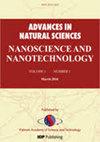A comparative photocatalytic degradation study of cationic and anionic dyes using ZnIn2S4 photocatalyst
IF 2.1
Q3 MATERIALS SCIENCE, MULTIDISCIPLINARY
Advances in Natural Sciences: Nanoscience and Nanotechnology
Pub Date : 2023-03-01
DOI:10.1088/2043-6262/acc732
引用次数: 2
Abstract
Semiconductor mediated photocatalysis has emerged as a promising solution for dye degradation and environmental remediation. Zinc Indium Sulfide (ZnIn2S4, ZIS) is a benign, eco-friendly, visible-light-responsive photocatalyst, exhibiting excellent optoelectronic properties. In this work, we present a scalable, low temperature and template-free chemical aqueous solution method for the synthesis of ZIS. The obtained powder sample was used for a comparative dye degradation study of cationic (Malachite green) and anionic (Congo red) dye. The higher photocatalytic efficiency of ZIS is due to the higher BET surface area (55.042 m2 g−1) and low band gap (2.3 eV). Under Sunlight, almost 80 percent degradation occurs within 20 min of the experiment for both Malachite green (MG) and anionic Congo red (CR) dye, outperforming previously reported results. Scavenger studies were used to figure out the radicals involved in photocatalytic mechanics and to come up with viable photocatalytic degradation routes. The reusability and stability of ZIS were carried out up to the 5th cycles. Our result revealed that ZIS possesses high stability, reusability, and efficient potential to be an effective dye degradation photocatalyst.ZnIn2S4光催化剂对阳离子和阴离子染料的光催化降解比较研究
半导体介导的光催化已成为染料降解和环境修复的一种有前途的解决方案。硫化锌铟(ZnIn2S4, ZIS)是一种良性、环保、可见光响应的光催化剂,具有优异的光电性能。在这项工作中,我们提出了一种可扩展、低温、无模板的化学水溶液合成ZIS的方法。所得粉末样品用于阳离子(孔雀石绿)和阴离子(刚果红)染料的染料降解比较研究。ZIS具有较高的光催化效率,这是由于ZIS具有较高的BET表面积(55.042 m2 g−1)和较低的带隙(2.3 eV)。在阳光照射下,孔雀石绿(MG)和阴离子刚果红(CR)染料在20分钟内降解率几乎达到80%,优于先前报道的结果。利用清道夫研究来研究参与光催化机理的自由基,并提出可行的光催化降解途径。ZIS的可重复使用性和稳定性达到了5次循环。结果表明,ZIS具有较高的稳定性、可重复利用性,是一种有效的染料降解光催化剂。
本文章由计算机程序翻译,如有差异,请以英文原文为准。
求助全文
约1分钟内获得全文
求助全文
来源期刊

Advances in Natural Sciences: Nanoscience and Nanotechnology
NANOSCIENCE & NANOTECHNOLOGYMATERIALS SCIE-MATERIALS SCIENCE, MULTIDISCIPLINARY
自引率
4.80%
发文量
0
 求助内容:
求助内容: 应助结果提醒方式:
应助结果提醒方式:


